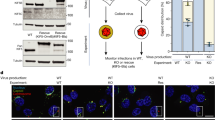Abstract
CHIKUNGUNYA virus is one of the best inducers of interferon in chick cells, and many of the conditions which affect the yield of interferon have been elucidated1,2. This communication reports an investigation of the relationship between the amount of Chikungunya virus inoculated into chick cell cultures and the subsequent yield of interferon. Dilutions of Chikungunya virus were prepared and placed in bottle cultures of chick cells which were then placed at 37° for 24 h. Supernatant fluids were collected, heated at 65° for 30 min to inactivate the virus, and assayed for interferon using the procedure of Linden-mann and Gifford3. The PDD50, defined as the amount of interferon preparation required to depress the plaque count to 50 per cent of the control value3, was determined and plotted against the logarithm of the ratio of plaque-forming units/cell (Fig. 1). Less interferon was found to be produced by the cultures which received the greatest amount of virus than by those which were infected with approximately 0.1 plaque-forming units/cell. Even with 0.01 plaque-forming units/cell a considerable amount of interferon was produced. Three experiments have all given similar results. In other experiments fresh medium was placed on interferon producing cultures 24 h after infection and re-incubated for an additional 24 h. The amount of interferon found was usually less than 15 per cent of the first 24-h yield, indicating that most of the interferon was produced in the first 24 h after infection.
This is a preview of subscription content, access via your institution
Access options
Subscribe to this journal
Receive 51 print issues and online access
$199.00 per year
only $3.90 per issue
Buy this article
- Purchase on Springer Link
- Instant access to full article PDF
Prices may be subject to local taxes which are calculated during checkout
Similar content being viewed by others
References
Ruiz-Gomez, J., and Isaacs, A., Virology, 19, 1 (1963).
Ruiz-Gomez, J., and Isaacs, A., Virology, 19, 8 (1963).
Lindenmann, J., and Gifford, G. E., Virology, 19, 302 (1963).
Burke, D., and Isaacs, A., Brit. J. Exp. Path., 39, 78 (1958).
Gifford, G. E., and Heller, E., Nature, 200, 50 (1963).
De Maeyer, E., and De Somer, P., Nature, 194, 1252 (1962).
Lindenmann, J., Z. Hyg. Infektionskrankh., 146, 287 (1960).
Author information
Authors and Affiliations
Rights and permissions
About this article
Cite this article
GIFFORD, G. Variation of Interferon Yield with Multiplicity of Infection. Nature 200, 91–92 (1963). https://doi.org/10.1038/200091a0
Issue Date:
DOI: https://doi.org/10.1038/200091a0
This article is cited by
-
Interferon induction in hamster embryo cells and newborn hamsters infected with polyoma virus
Archiv f�r die gesamte Virusforschung (1970)
-
Some factors affecting interferon production by foot-and-mouth disease virus in bovine tissue cultures
Archiv f�r die gesamte Virusforschung (1968)
Comments
By submitting a comment you agree to abide by our Terms and Community Guidelines. If you find something abusive or that does not comply with our terms or guidelines please flag it as inappropriate.



